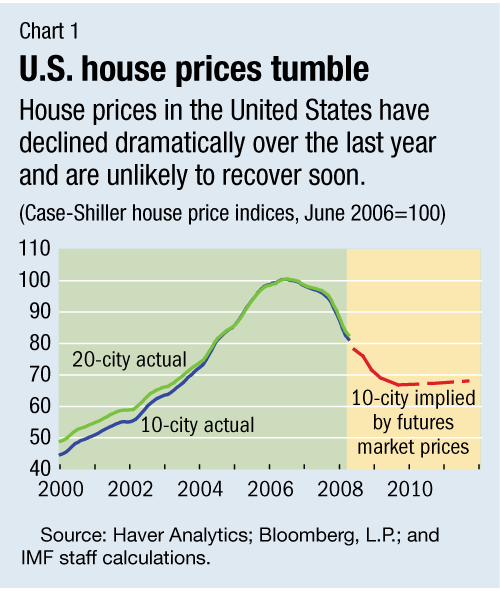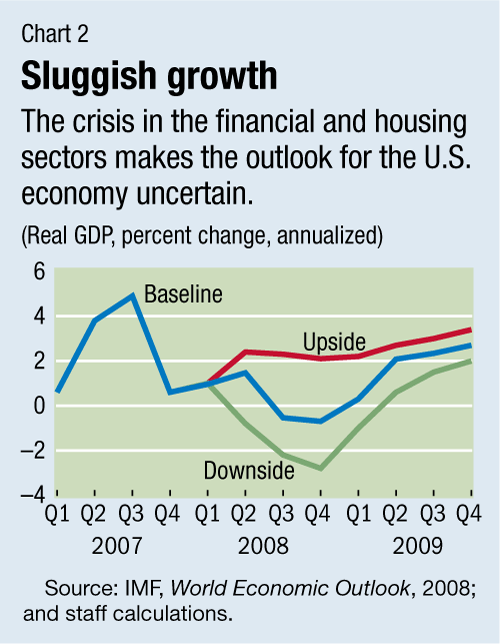
Typical street scene in Santa Ana, El Salvador. (Photo: iStock)
IMF Survey: United States Manages First Housing Bust in Four Decades
August 1, 2008
- U.S. economic growth will be sluggish through 2009
- IMF says accommodative money policy should stay on hold for now
- Notes constraints on spending call for targeted fiscal response
Considering the severity of the shocks it has faced, including the first nationwide decline in house prices in four decades, the U.S. economy has held up well so far, the IMF concluded in its recently completed annual consultation with U.S. authorities.

Derelict house in Detroit, United States: Stresses in housing, financial markets will require creative thinking by U.S. authorities, IMF says (photo: Newscom)
ANNUAL ECONOMIC HEALTH CHECK
Substantial monetary and fiscal stimulus, buoyant net exports, and healthy corporate balance sheets have provided welcome support. However, their effect is being blunted by growing strains on household and bank finances, and higher commodity prices. These strains, which have yet to fully feed through to domestic demand and activity, will take time to work out.
As a result, IMF staff projects that real GDP growth between the fourth quarter of 2007 and the fourth quarter of 2008 will be quite low and it will recover only gradually in 2009. Although inflation expectations have ticked up because of surging commodity prices, price pressures should be contained as commodity prices peak and economic slack rises.
Uncharted waters
The annual Article IV Consultation covered uncharted waters, as U.S. authorities sought to cope with the effects of financial market turmoil that had its roots in the subprime mortgage market. This year the government has had to rescue a major investment bank and the two main housing government-sponsored enterprises (GSEs), Fannie Mae and Freddie Mac.
The unusual nature of the ongoing crisis in the financial and housing sectors leaves the outlook highly uncertain. The outlook crucially hinges on the evolution of house prices (see Chart 1), and the dynamic interaction of the financial sector and housing cycles.

A more rapid recovery is clearly possible, given the substantial policy stimulus and forceful moves by financial institutions to repair their balance sheets. However, the economy is facing historically unprecedented shocks, financial conditions currently presage further tightening, and there is a worrisome possibility that weakening activity will feed back into further bank losses, generating a longer slowdown (see Chart 2).

Navigating through trying times
Dealing with the serious stresses in housing and financial markets has created the need for some creative thinking from the U.S. authorities—including new liquidity facilities from the central bank, the Federal Reserve. Those facilities, established to accommodate commercial banks with liquidity needs, were extended to investment banks this year and authorities just announced the facilities will be available to non-commercial banks until January.
In addition, a recently passed housing bill seeks to limit the impact of foreclosures on the economy. Earlier this year the government provided substantial fiscal stimulus and the Fed provided substantial monetary stimulus.
The U.S. economy is at an admittedly complex juncture. According to the IMF staff report, monetary policy should stay on hold for now. The staff noted that fiscal policy, which is providing support at a critical time now, is constrained by medium- and long-term fiscal issues. The staff made a number of observations on macroeconomic and fiscal policies:
Monetary Policy. Even though financial conditions are expected to remain tight, the real fed funds rate, the central bank's short-term policy rate, is already negative and, as a result, monetary policy is providing a robust response to recession risks. Meanwhile, although wage demands remain moderate, elevated headline inflation has begun to seep into near-term inflation expectations. Given the risks that medium-term expectations for inflation also begin to increase and the high cost of reversing such expectations once they become entrenched, the bias going forward should be toward a decisive tightening once recovery is established and financial conditions ease further.
Fiscal Policy. The fiscal stimulus package was relatively well targeted toward those who are most likely to spend the money, and its rapid passage in Congress has ensured its benefits are timely. While automatic stabilizers should be allowed to operate, in the face of significant medium-term fiscal challenges, any needed further government support should focus on using balance sheets to support housing and financial markets, such as the recently approved housing bill. A more ambitious medium-term target of fiscal balance excluding the social security surplus as well as major entitlement reform remain key to restoring fiscal sustainability.
Given the risks, the government should be prepared to widen support for housing and, if serious dislocations reappear, in financial markets, beyond that already provided for in the housing bill. Policies need to be mindful of moral hazard, that the housing sector is already the recipient of large tax subsidies, and that house prices still need to adjust down.
Still, there is a clear risk that prices could fall significantly below equilibrium, with painful economic results. The recently enacted housing package will serve to limit potential adverse developments, but further policy actions probably will be required. For instance, major systemic financial disruptions could recur and, if they do, the U.S. Treasury could support market stability by significantly extending the term of asset swaps—a move similar to what has been done in the United Kingdom.
Implications for financial regulation
The housing boom revealed several weaknesses in financial regulation and supervision. While private sector responses will plug some of the gaps, the Treasury blueprint for financial reform, which includes many proposals highlighted in last year's IMF staff report, provides a sensible basis for comprehensive reform.
Pending further analysis, including under the Financial Sector Assessment Program, reform options could include reducing the procyclicality of bank lending (by augmenting risk-based capital ratios, for example) and bringing the oversight of major investment banks and government-sponsored enterprises closer to that of commercial-bank holding companies.
Finally, with liquidity having emerged as a major and underemphasized risk, draft recommendations from the Basel Committee will need to be implemented swiftly, taking into account U.S.-specific considerations.
Comments on this article should be sent to imfsurvey@imf.org


